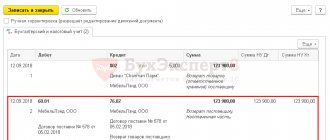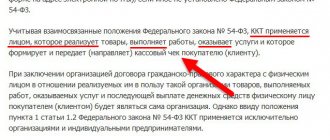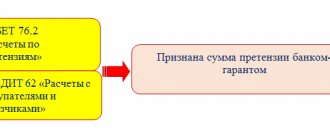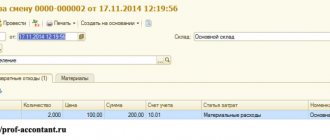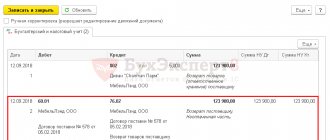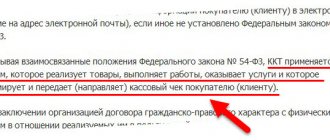What is a commodity loan?
Standard loans are usually taken out to purchase any goods or material assets. However, instead of money, the entrepreneur can immediately take these goods/things. In this case, there is an obligation to return them. Typically, an agreement on such loans is concluded between two legal entities.
Commodity loan agreement: what affects taxes and accounting for the borrower ?
The transfer of things, not money, is the main characteristic of commodity loans. Other nuances are determined by the specific agreement:
- The presence or absence of interest.
- The obligation to return the same asset or similar thing.
Commodity loans are a special form of lending. Drawing up an agreement on such a loan requires compliance with a number of rules.
How is the lender's accounting done when the borrower repays a commodity loan ?
Sample of a commodity loan agreement
An important condition is that the document must be drawn up in writing on paper, and must also be affixed with personal signatures by representatives of both parties.
The mandatory clauses of a commodity loan agreement are:
| Details of the parties | it is necessary to carefully enter the full name of citizens or the full name of organizations, registration address, other data (TIN, OGRN, etc.) |
| Term | a mandatory condition, since without specifying the duration of the action it is impossible to fulfill the lender’s requirements and apply penalties |
| Lending terms | availability and amount of interest, date of transfer of goods, etc. |
| Description of the subject of the agreement | It is important to enter all the necessary characteristics of the goods, since in most cases the loan is repaid with similar products, therefore, in order not to incur financial losses in the future, a careful description of the materials, raw materials, fuel, etc. provided is necessary. |
| Name of product | quantity of goods purchased on credit and its generic characteristics |
Since there is no clearly established form of a commodity loan agreement, the parties have the opportunity to add the necessary information or additional clauses to the draft document.
For example, information about the range and/or quality of transferred goods.
It is important to remember that, unlike other civil documents, such a document is considered concluded not from the moment it is signed or registered, but only after the goods are transferred to the borrower.
Between legal entities
A loan agreement between legal entities is not something out of the ordinary and is considered a standard transaction.
To optimize costs and reduce the tax burden, it is necessary that both parties apply the same taxation system:
- General system (OSNO).
- Simplified (USN).
- System of a single tax on imputed income (UTII).
- System of the Unified Agricultural Tax (USAT).
- Patent system.
With a physical person
Concluding a commodity loan agreement is not only permissible in accordance with Russian legislation, but is also a fairly common occurrence in the business environment of the Russian Federation.
Citizens can act in the following capacities:
| Be a creditor | provide enterprises and organizations with goods, materials, raw materials, etc. at a certain percentage for a specified period |
| Be a borrower | undertake obligations for the timely return of similar goods |
Since most individuals use the OSNO tax system, before concluding an agreement, it is necessary to calculate the profitability of the transaction and realistically assess its necessity and usefulness for the business.
Its peculiarity is that both the transfer of goods and its return from the point of view of tax authorities is a sale, that is, subject to mandatory taxation (VAT).
Read about the additional agreement to the loan agreement on changing the repayment period in the article: additional agreement to the loan agreement in 2021. How to take out a private loan in person in 2021, read here.
If the total cost of the loan is a significant amount, then there is a high probability of spending a lot on taxes.
From the founder
Company founders often resort to commodity loans when it is necessary to urgently transfer the necessary materials, raw materials, fuel or other goods from one legal entity to another.
This operation is a “lifesaver” for legal entities in case of delays in deliveries.
Legislative justification
Obtaining commodity loans is regulated by Chapter 42 of the Civil Code of the Russian Federation. Article 807 of the Code states that in case of commodity (non-monetary) loans, a person is provided with a certain item. He is obliged to return an item with similar generic characteristics. The latter refers to these characteristics:
- Volume of production.
- Quality.
- Type of packaging.
- Width of assortment, etc.
When describing the objects provided, you can use the standard rules that are relevant when concluding a purchase and sale agreement.
Loan repayment: property instead of money
In such cases, tax risks are likely. If the value of the property exceeds the terminated obligation, then the risks arise with the receiving party (the lender). Officials believe that in this situation the organization must reflect non-operating income on which it is necessary to pay income tax. This conclusion can be seen, for example, in Letters of the Ministry of Finance of the Russian Federation dated February 3, 2010 No. 03-03-06/1/42, Federal Tax Service of Russia for Moscow dated December 5, 2007 No. 19-11/116142. By taxing this difference to income tax, the company will eliminate tax risks.
We recommend reading: Resettlement of Emergency Housing in the Regions 2020
Documenting
The main document that governs the receipt of a commodity loan is an agreement. When drawing up it, you need to take into account the nuances of the form of lending in question, as well as the rules for drawing up a purchase and sale agreement. Let's consider all the nuances of drawing up a contract:
- A clause is indicated on the right to transfer ownership of a thing from one legal entity to another.
- The provisions of a standard purchase and sale agreement are prescribed: type of asset, its characteristics, quantity.
- Additional items are indicated: availability of interest, loan repayment terms.
As a rule, the contract contains information about the real value of the transferred object.
FOR YOUR INFORMATION! The agreement is recognized as concluded from the date of transfer of the thing on the basis of Article 760 of the Civil Code of the Russian Federation. If an agreement is concluded between legal entities, it must be drawn up in writing (clause 1 of Article 761 of the Civil Code of the Russian Federation). The debtor must return the object within the time period specified in the agreement.
Important points
When providing a trade loan, you need to pay attention to important details:
- legitimacy of the contract - all clauses of the document must comply with the norms of current legislation so that no problems arise;
- oral agreements are necessarily transferred to paper, and this should not depend on the personal acquaintance of the lender and the borrower, their relationship and other extraneous factors;
- deadlines for returning products, the procedure for calculating penalties in case of violation of the established time period, etc.;
- the most complete information about the products that are the subject of the contract, all existing technical characteristics that are of any importance when concluding the relevant contract.
Taxation
The item received and returned does not affect the calculation of income tax. Objects are not required to be included either in the structure of income (clause 1 of Article 251 of the Tax Code of the Russian Federation) or in the structure of expenses (clause 12 of Article 270 of the Tax Code of the Russian Federation). Commodity loans sometimes involve interest charges. In this case, the accumulated interest is included in the structure of non-operating expenses (clause 1 of Article 265 of the Tax Code of the Russian Federation). However, it is necessary to take into account the restrictions listed in Article 269 of the Tax Code of the Russian Federation. If you receive an interest-free loan, no income is generated from the lack of interest.
The actual value of the item received and returned may vary. How to take into account the difference when determining income tax? There is no clear explanation in the law on this matter. The term “amount differences” is in Chapter 25 of the Tax Code of the Russian Federation, but it does not apply to the lending operations under consideration.
When determining income tax on a commodity loan, the difference is not taken into account. This is explained by the fact that a loan in kind does not need to be included in the structure of income (clause 1 of Article 251 of the Tax Code of the Russian Federation) and the structure of expenses (clause 12 of Article 270 of the Tax Code of the Russian Federation).
The issuance and receipt of commodity loans is subject to VAT. Can it be taken as a deduction? Not long ago, paragraph 4 of Article 168 of the Tax Code of the Russian Federation appeared, according to which VAT will be deductible on standard grounds.
Let's look at the transactions that allow you to take VAT into account:
- DT10 KT66, 67. Obtaining a commodity loan.
- DT19 KT66, 67. Allocation of VAT on assets received.
- DT68 KT19. Acceptance of VAT deduction.
VAT will also be charged on interest. However, this only applies to those interests whose amount exceeds the limit. The latter is determined by the Central Bank refinancing rate (subparagraph 3, paragraph 1, Article 162 of the Tax Code of the Russian Federation). The VAT rate is established by calculation method (clause 4 of Article 164 of the Tax Code of the Russian Federation).
The transfer of things and their shipment to repay the loan do not constitute expenses on the basis of paragraph 12 of Article 270 of the Tax Code of the Russian Federation. Only interest on the loan will be recorded in tax accounting.
Features of the contract and its sample
Many people do not know how to properly draw up a commodity loan agreement. At the moment, Russian legislation describes the differences between a loan agreement and a credit agreement, as well as certain parameters of some of their forms. The commodity lending agreement consists of parts that relate, among other things, to purchase and sale.
As for the main features of an agreement of this format, it includes the following points:
- The document type includes the parameters that are applied by the loan;
- The ability to conclude a transaction between any category of participants without interest;
- If obligations are not fulfilled, the creditor has the right to present the borrower with an obligation to repay the debt along with interest;
- A credit agreement can be concluded by a bank or other organizations that are vested with the appropriate license.
As for a loan, it can be issued or received by any type of borrower. The most common options for commodity loan agreements are presented in the following list:
- Between individuals in the absence of participation of organizations in the transaction;
- A legal entity with an individual;
- Between legal entities.
The trade credit agreement must indicate the specifics of the items being transferred. The document must also indicate the monetary value of the item.
Between individuals
According to current legislation, there are no prohibitions on issuing and receiving loans when the participants are two individuals. Such an agreement can be concluded in writing and must contain the passport details of each participant.
Peculiarities:
- The imperfection of the actual legislation in Russia can create some problems for those people who issue loans systematically;
- If a person is not registered as an individual entrepreneur, then the tax authorities will regard this activity as illegal execution of entrepreneurial activity;
- Such activities on a large scale may fall under the conditions of Article 172 of the Criminal Code of the Russian Federation;
- Not the most pleasant consequences can be avoided in situations where the scale of activity in the absence of registration is not brought to such volumes that it is possible to recognize the activities of the lender as a banking service in the absence of licensing documents.
Between legal entities
Among legal entities, such lending is currently quite popular. Because of this type of loan, the company has the opportunity to further develop its own activities without attracting investments from banks and founders.
Often, a trade credit can be issued by a supplier:
- True, intermediary organizations may also be involved here;
- If the agreement has an interest-based nature, along with the borrower’s violation of the terms of payment of the debt, the lender has the opportunity to demand repayment of the debt along with interest, which may accrue until the moment when the loan agreement ceases to exist.
Between an individual and a legal entity
In certain cases, enterprises are forced to turn to individuals to obtain a trade loan.
The most striking example is a loan from the founder:
- This activity is not prohibited at the legislative level, since individuals and enterprises are free to enter into agreements;
- Most often, enterprises borrow goods from their own founders. It is imperative to take into account that the return of a loan of a material nature will be considered their sale for the purpose of calculating VAT. Accordingly, the parties to the transaction will have to pay taxes.
If we look at the situation from the other side, we can understand that an individual is not a payer of such a fee. Accordingly, the transfer of goods from the creditor is not taken into account for tax deduction.
As for monetary transactions, they are exempt from VAT and that is why tax calculation issues are much easier to resolve with them. Also, the reverse situation cannot be ruled out here, in which the borrower is an individual who has received a trade loan from an enterprise.
Here you need to understand:
- Such activities cannot require a license only for small volumes;
- Otherwise, control authorities may equate it to a banking service, which implies taxation of this activity.
Accounting
The debtor must keep records of the loan on the basis of PBU 15/01 “Accounting for Loans”, established by Order of the Ministry of Finance No. 60n dated August 2, 2001. Calculations will be recorded on accounts 66 and 67. Debt is taken into account in the valuation of acquired assets (clause 3 of PBU 15/01).
The resulting assets must be capitalized at a value determined using the same algorithm that is used when valuing similar objects. However, an accountant can make his job easier. For the posting price, you can take the amount specified in the agreement. If no amounts appear in the contract, you can take the cost stated in the invoice.
The transfer of ownership rights to objects is considered a sale on the basis of paragraph 1 of Article 39. The operation is considered an object of taxation. In particular, it is subject to VAT.
Often, with a commodity loan, the debtor receives one item and returns another item with similar characteristics. In this case, the real value of the transferred assets may differ from the real value of the returned items. The difference that arises is attributed either to income or to expenses, depending on its positive or negative value. Differences are accounted for on the basis of PBU 18/02, approved by Order of the Ministry of Finance No. 114n dated November 19, 2002.
The lender must also take into account the commodity loans provided. Accounting is carried out on the basis of PBU 19/02, approved by the Ministry of Finance No. 126n dated December 10, 2002. Paragraph 3 of this act states that a trade loan will be considered a financial investment. The amount must be recorded in account 58. The loan is assessed based on the actual value of the transferred assets. After classifying things as financial investments, the cost of the objects is compared with their cost during regular sale without VAT. The resulting difference is attributed either to income or expenses.
Nuances of taxation. Value added tax
When transferring goods under a commodity loan (credit) agreement, ownership of the items passes from the lender to the borrower. Transfer of ownership, in accordance with clause 1 of Art. 39 of the Tax Code of the Russian Federation, means the fact of implementation that on the territory of the Russian Federation forms an object of VAT taxation (clause 1 of Article 146 of the Tax Code of the Russian Federation). This point of view is supported by the Supreme Court of the Russian Federation in its ruling dated March 13, 2015 No. 303-KG14-3334 in case No. A16-1423/2013.
If the borrowing is paid, the lender, when determining the taxable base for VAT, must also take into account the accrued interest for using the loan provided. Interest on a trade credit transaction, according to subparagraph. 3 p. 1 art. 162 of the Tax Code of the Russian Federation are subject to VAT in the amount exceeding the amount of interest calculated in accordance with the refinancing rates of the Central Bank of the Russian Federation in force at the time for which the interest is calculated.
Simultaneously with the calculation of VAT, the right to deduct the “input” amount of the same tax arises. Having received goods from the lender, the borrower has the right to present the amount of input VAT for deduction. Since repayment of a loan in kind is subject to VAT, the amount of input tax on property purchased to repay the loan can be deducted (subclause 1, clause 2, article 171 of the Tax Code of the Russian Federation).
Accounting for loans and borrowings
The first method reflects the average level of interest for several loans provided during one tax period under comparable conditions. Such conditions provide for the issuance of loans for the same period, in the same currency, in a comparable volume and with the same collateral. Then expenses are recognized as the amount of interest that does not deviate from the average interest rate on comparable loans by more than 20%. In practice, this method is rarely used due to the complexity of calculation and compliance with all conditions, but is more profitable.
For “simplers”, in accordance with letter No. ШС-37-3/1925 dated May 19, 2025, expenses associated with the repayment of a previously provided loan do not apply to the reduction of the tax base. This is due to the fact that the list of expenses from paragraph 1 of Article 346.16 of the Tax Code of the Russian Federation of organizations using the simplified tax system is limited. Interest paid for the use of loan funds is considered an expense that reduces the tax base. But it is necessary to take into account: if the loan was provided to an individual entrepreneur before his official registration, then the interest on this credit (loan) can no longer be attributed to expenses that reduce income (regardless of whether the loan was used in the activities of the individual entrepreneur).
How to record loans in accounting
The most common transactions that are entered into the accounting journal are loans and borrowings, because of this it is necessary to understand how these financial procedures differ from each other. We can find out the differences by referring to the norms of civil legislation of the Russian Federation.
The accounting separately indicates the amount where the body of the loan is indicated (that is, the money that the client received personally) and the amount of costs that will need to be repaid for using the loan funds (interest).
Reflection of a loan under the simplified tax system (USN) income minus expenses (nuances)
Neither the funds received as borrowed nor the funds issued are considered either income or expenses of the taxpayer working on the simplified tax system. Accordingly, the return of these funds will not be regarded as either income or expense. Regarding income, this conclusion follows from the content of Art. 346.15 of the Tax Code of the Russian Federation, referring to Art. 251 of the Tax Code of the Russian Federation, in which sub. 10 clause 1 directly indicates that such funds should not be considered income. And as part of the expenses, the closed list of which contains Art. 346.16 of the Tax Code of the Russian Federation, borrowed funds are not specified.
We recommend reading: Cost of Hot Water Krasnoyarsk 2021
Funds transferred into debt are not taken into account either in income or expenses, or when issuing (receiving) or when returning. The income of the party issuing the loan and the expense of the recipient will be the fee for the use of borrowed funds: interest stipulated by the loan agreement. In accounting, they are accrued, as a rule, monthly, and they can be taken into account in income or expenses for the purposes of calculating the simplified tax system only at the time of actual receipt or payment, respectively.
Loan repayment by posting goods
Due to financial and other objective reasons, organizations can enter into loan agreements for the transfer of raw materials.
In this case, the cost of returned materials may be higher (lower) than the cost of materials received under the contract. Today I propose to consider what the legal nature of such agreements is and how to take into account the operations of obtaining and returning a commodity loan from the borrower. How to correctly reflect in accounting and tax accounting operations for obtaining and returning a commodity loan, if the cost of the returned materials may be higher or lower than the cost of the materials received under the contract?
Accounting for bills of exchange with examples and postings
There are two types of bills: financial (confirming a debt financial obligation for a specific amount) and commodity (confirming a debt monetary obligation in the form of a good or service described in the bill to the drawer). For commodity transactions, the following postings are made:
- The name of the document (in this case it is a bill of exchange).
- Loan amount.
- Agreed return period subject to conditions.
- The name of the payer in a legally established form.
- A description and approval of the location where payment for this obligation will be made.
- Formation of the date and place where this document was compiled.
- Signature of the note holder.
